engine overheat CADILLAC SEVILLE 1997 4.G Owners Manual
[x] Cancel search | Manufacturer: CADILLAC, Model Year: 1997, Model line: SEVILLE, Model: CADILLAC SEVILLE 1997 4.GPages: 370, PDF Size: 20.52 MB
Page 2 of 370
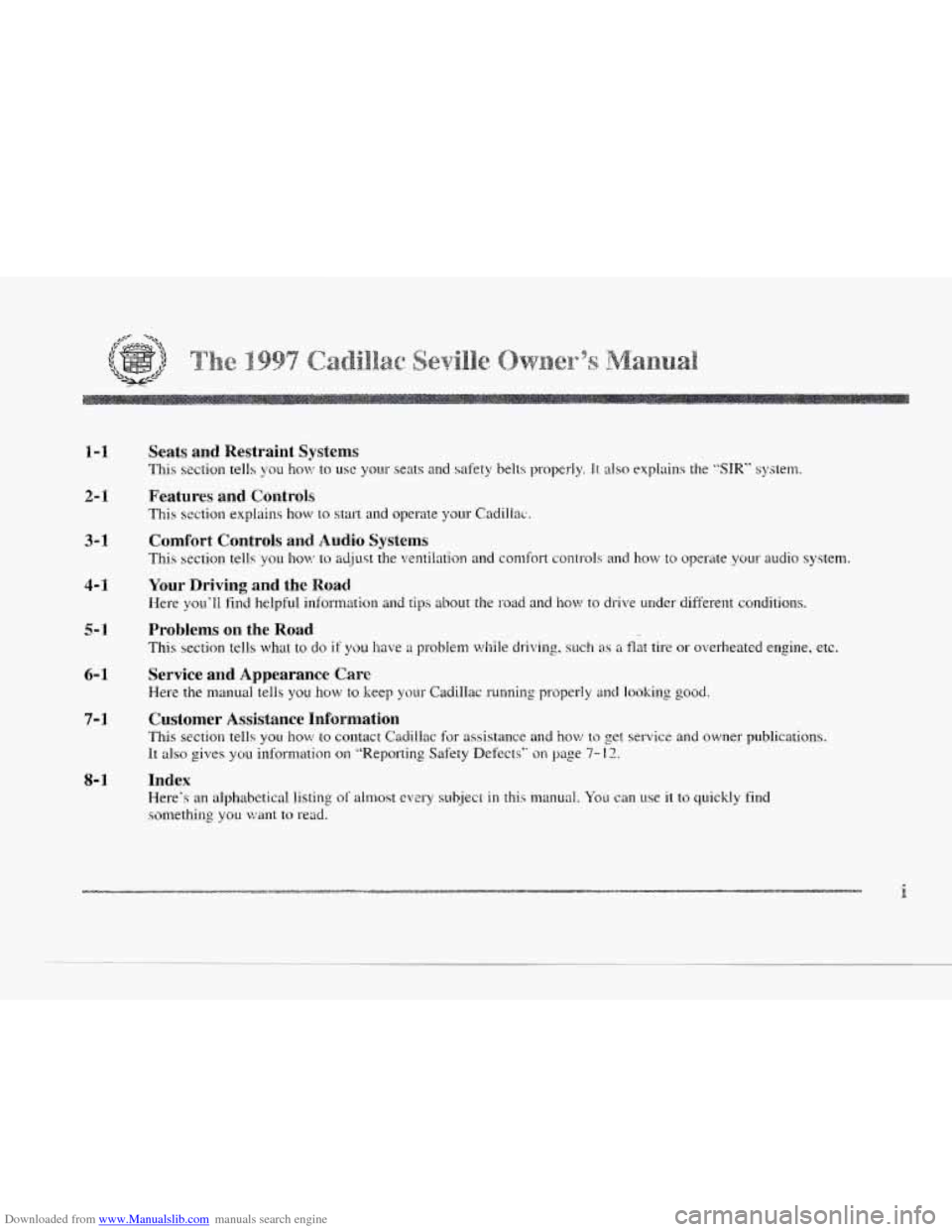
Downloaded from www.Manualslib.com manuals search engine c
c
1-1
2- I
3-1
4- I
5-1
6- 1
7-3
8-1
Seats and Restraint Systems
This section tells you how to use your seats and safety belts properly. It also explains the "SIR" system.
Features and Controls
This section explains how to start and operate your Cadiliac.
Comfort Controls and. Audio Systems
This section tells you how to acljust the ventilation and comfort controls and how to operate your audio system.
Your Driving and the Road
Here you'll find helpful information and tips about the road and how to drive under different conditions.
Problems on the Road
This section tells what to do if you have a problem while driving, such as a flat tire or overheated engine, etc.
Service and Appearance Care
Here the manual tells you how to keep your Cadillac running properly a1~1 loolting good.
Customer Assistance Information
This section tells you how to contact Cadillac for assistance and how tu get service and owner publications.
It also gives
you information on "Reporting Safety Defects" on pase 7- 1 I?.
Index
Here's an alphabetical listing of almost every subject in this manurd. You can use it to quickly find
something you want to read.
i
Page 84 of 370
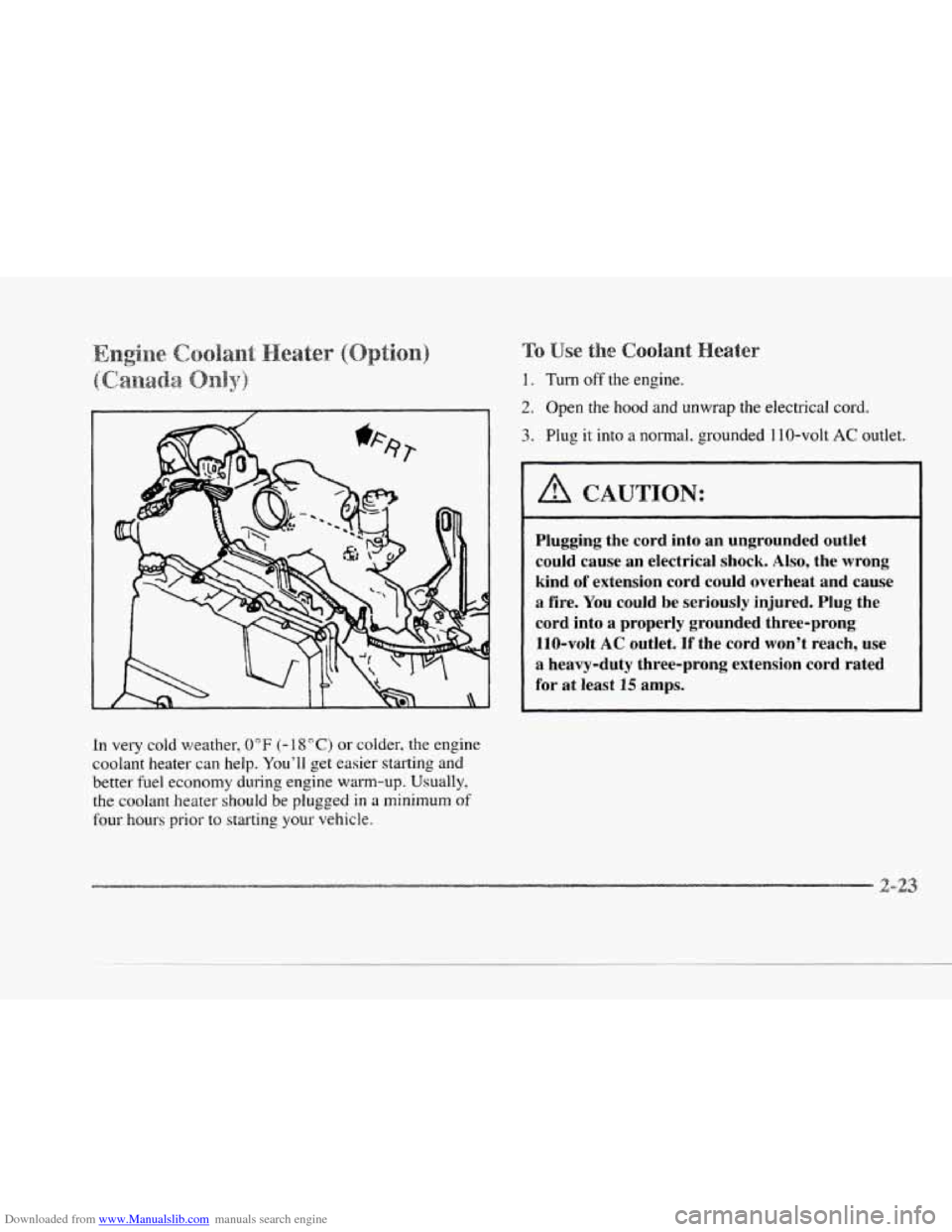
Downloaded from www.Manualslib.com manuals search engine c
rc In very cold weather, 0" F (- 1 8" C) or colder, the engine
coolant heater can
help. You'll get easier starting and
better fuel economy during engine warm-up. Usually,
the coolant heater should be plugged in a minimum of
four hours prior to starting your vehicle.
se the Coolant
1. Turn off the engine.
2. Open the hood and unwrap the electrical cord.
3. Plug it into a normal. grounded 1 10-volt AC outlet.
CAUTION:
Plugging the cord into an ungrounded outlet
could cause an electrical
shock. Also, the wrong
kind
of extension cord could overheat and cause
a fire.
You could be seriously injured. Plug the
cord into a properly grounded three-prong
110-volt
AC outlet. If the cord won't reach, use
a heavy-duty three-prong extension cord rated
for at least
15 amps.
c -23
Page 88 of 370
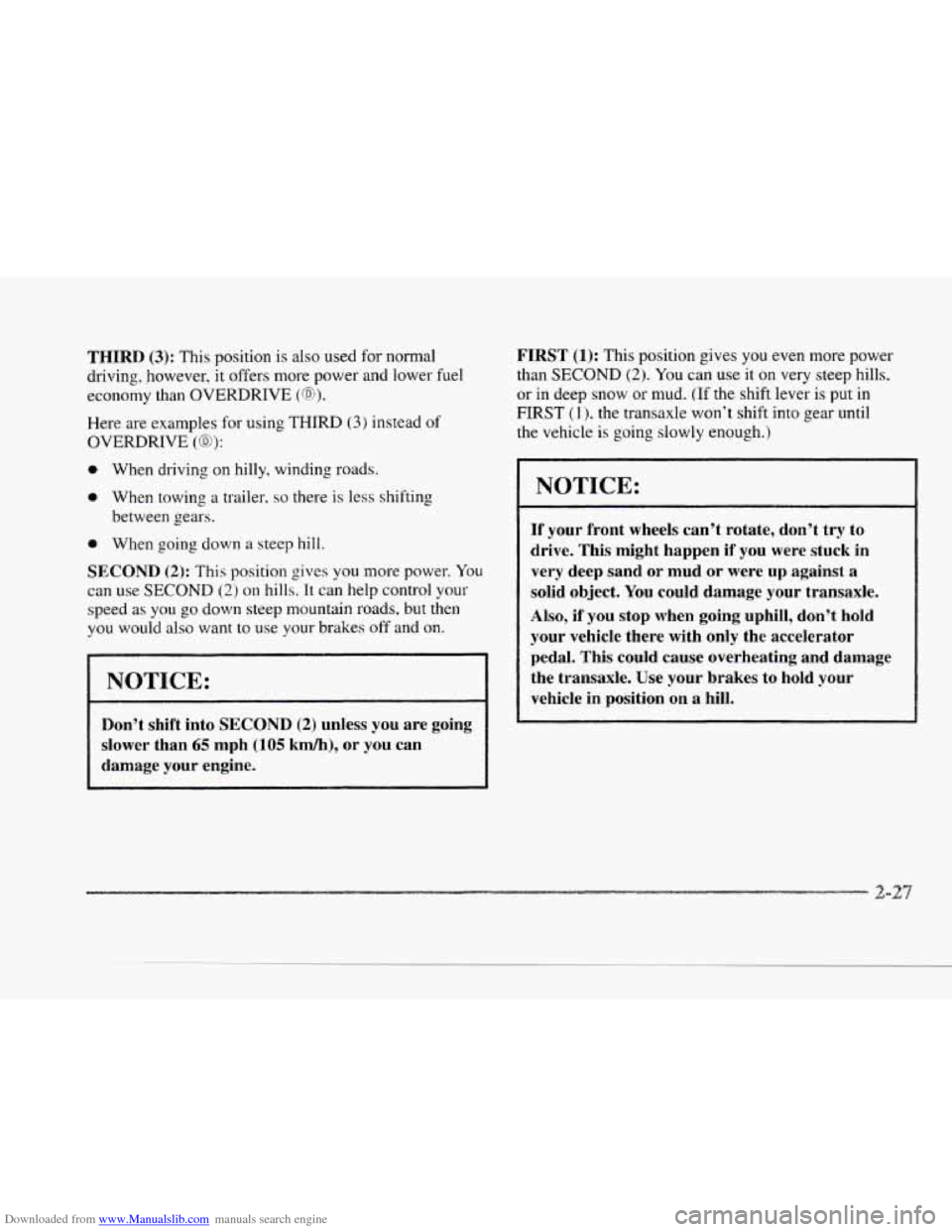
Downloaded from www.Manualslib.com manuals search engine c
c
THIRD (3): This position is also used for normal
driving, however,
it offers more power and lower fuel
economy than OVERDRIVE
(@).
Here are examples for using THIRD (3 j instead of
OVERDRIVE (@) j:
0 When driving on hilly, winding roads.
0 When towing a trailer. so there is less shifting
between gears.
0 When going down a steep hill.
SECOND (2): This position gives you more power. You
can use SECOND (2) on hills. It can help control your
speed
as you go down steep mountain roads, but then
you would also want to use your brakes off and on.
.__
NOTICE:
Don’t shift into SECOND (2) unless you are going
slower than
65 mph (105 km/h), or you can
damage your engine.
FIRST (1): This position gives you even more power
than SECOND
(2). You can use it on very steep hills,
or in deep snow or mud. (If the shift lever is put in
FIRST (1). the transaxle won’t shift into gear until
the vehicle is
going slowly enough.)
NOTICE:
If your front wheels can’t rotate, don’t try to
drive. This might happen
if you were stuck in
very deep sand or mud or were up against a
solid object. You could damage your transaxle.
Also, if you stop when going uphill, don’t hold
your vehicle there with only the accelerator
pedal. This could cause overheating and damage
the transaxle. Use your brakes
to hold your
vehicle
in position on a hill.
Page 90 of 370
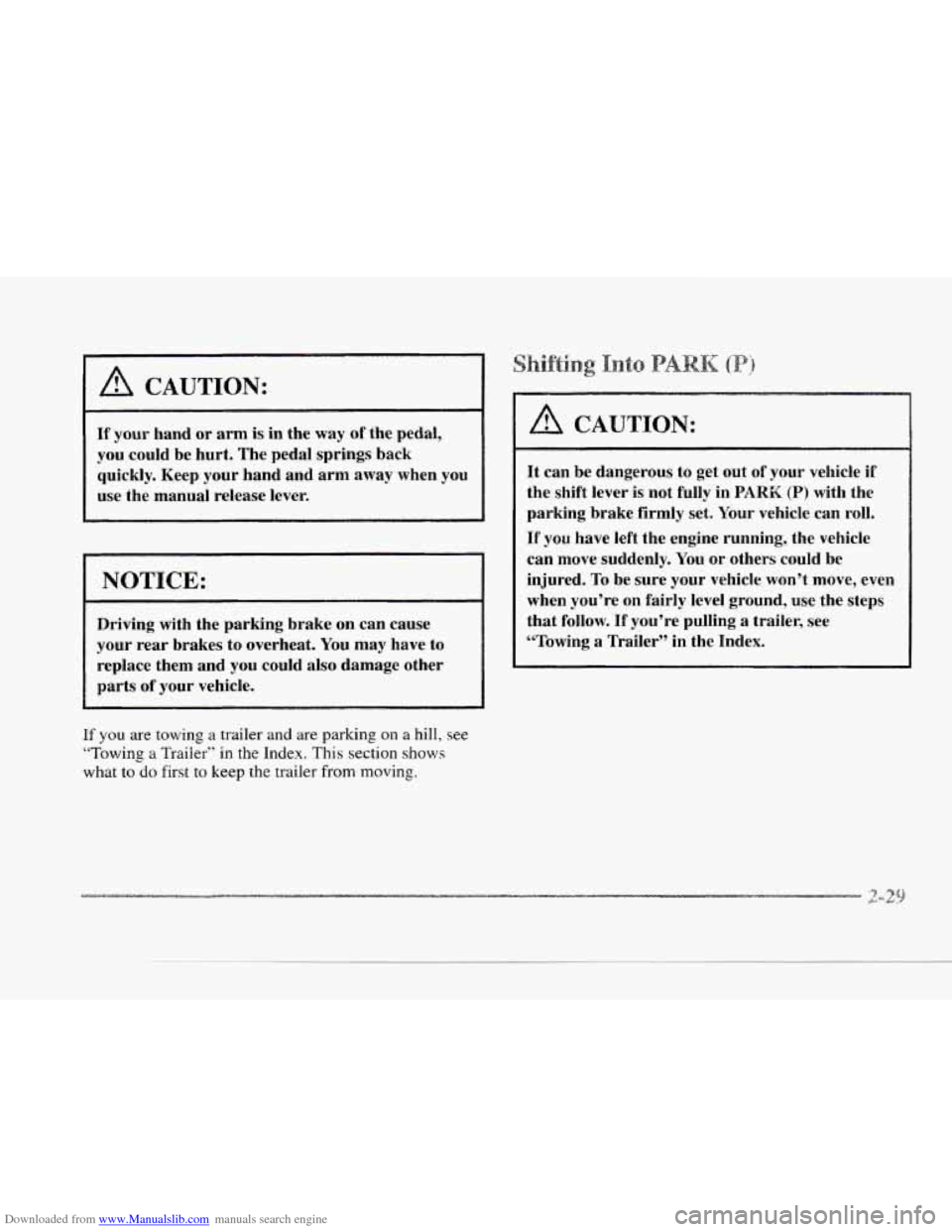
Downloaded from www.Manualslib.com manuals search engine I A CAUTION:
If your hand or arm is in the way of the pedal,
you could be hurt. The pedal springs back
quickly. Keep your hand and
arm away when you
use the manual release lever.
NOTICE:
Driving with the parking brake on can cause
your rear brakes to overheat.
You may have to
replace them and
you could also damage other
parts
of your vehicle.
If you are towing a trailer and are parking on a hill, see
what to do first to keep the trailer from moving.
6b Towing a Trailer” in the Index. This section shows
A CAUTION:
It can be dangerous to get out of’ your vehicle if
the shift lever is not fully in PARK (P) with the
parking brake firmly
set. Your vehicle can roll.
If you have left the engine running, the vehicle
can move suddenly.
You or others could be
injured.
To be sure your vehicle won’t move, even
when you’re
on fairly level ground, use the steps
that follow.
If you’re pulling a trailer, see
“Towing a Trailer” in the Index.
Page 92 of 370
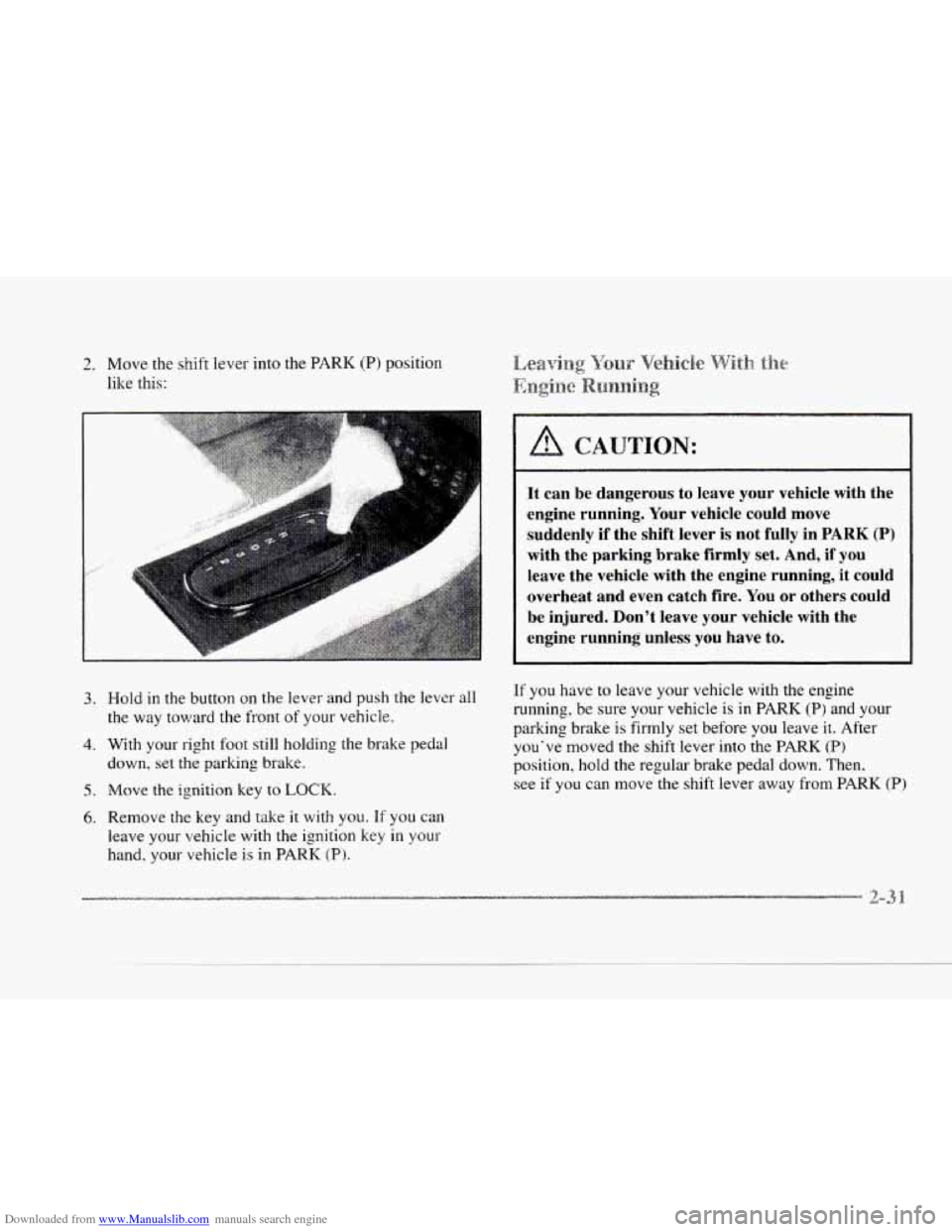
Downloaded from www.Manualslib.com manuals search engine 2. Move the shift lever into the PARK (P) position
like this:
c
I
3.
c
... . .. ... . ..: . ..
4.
5.
6.
It can be dangerous to leave your vehicle with the
engine running. Your vehicle could move
suddenly
if the shift lever is not fully in PARK (P)
with the parking brake firmly set. And, if you
leave the vehicle with the engine running, it could
overheat and even catch fire. You or others could
be injured. Don't leave your vehicle with the
engine running unless you have to.
Hold in the button on the lever and push the lever all
the way toward the front of your vehicle.
With your right foot still holding the brake pedal
down,
set the garlung brake.
Move,
the ignition key to LOCK.
Remove the key and take it with you. If you can
leave your vehicle with the ignition key in
your
hand, your vehicle is in PARK (P}.
If you have to leave your vehicle with the engine
running, be sure your vehicle is in PARK
(P) and your
parking brake is firmly set before you leave it. After
you've moved the shift lever into the
PARK (P)
position, hold the regular brake pedal down. Then.
see if
you can move the shift lever away from PARK (P)
Page 121 of 370

Downloaded from www.Manualslib.com manuals search engine *;!&fgyg.yS 8 ignd ~~~~~~~~~ .%
With the full center console, press on the cover, which is
located below the climate control system, to reveal the
front ashtray.
To clean this ashtray, lift it out by gripping
the sides. If you don’t have a center console, pull the
tray
out to reveal the ashtray. The tray is located beneath
the radio.
To clean this ashtray, lift it out by pulling on
the snuffer.
To use the rear ashtray, lift the lid.
NOTICE:
Don’t put papers or other flammable items
into your ashtrays. Hot cigarettes or other
smoking materials could ignite them, causing
a damaging fire.
The cigarette lighter is located near the ashtray. Press
it all the way in and release. It will pop back by itself
when it’s ready to light.
You may also have a lighter
on the back of the center console near the rear seat
air
outlet.
Note that power to the cigarette lighter will shut off
10 minutes after the ignition is turned off. This helps
to prevent battery drainage. For more information,
see “Inadvertent Power Battery Saver” earlier in
this section.
NOTICE:
Don’t hold a cigarette lighter in with your hand
while it
is heating. If you do, it won’t be able to
back away
from the heating element when it’s
ready. That can make it overheat, damaging the
lighter and the heating element.
Swing down the visor to block out glare. It can also be
detached from
the center mount and moved to the side.
The driver‘s sunshade is also equipped with a storage
flap that can be used for maps or toll tickets.
Page 140 of 370
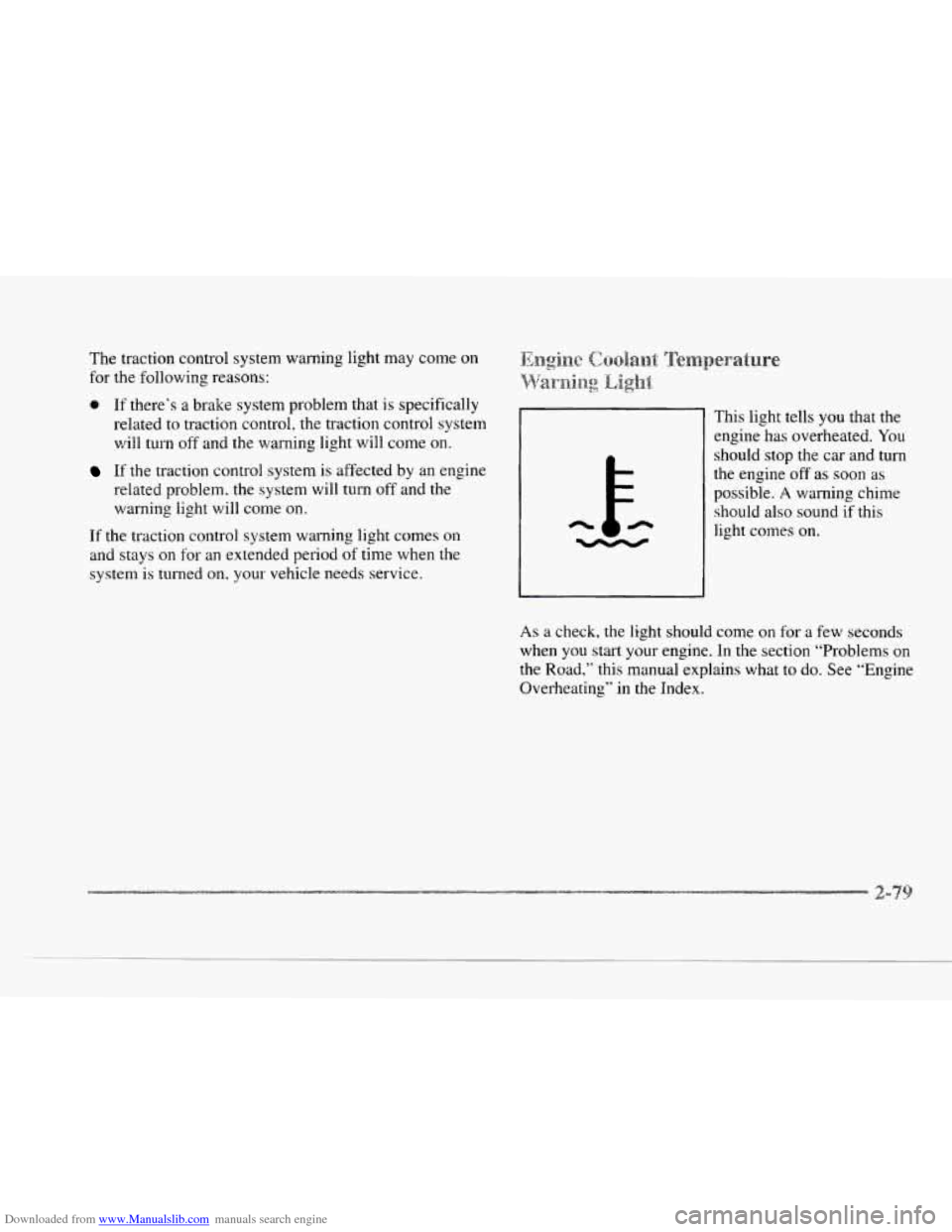
Downloaded from www.Manualslib.com manuals search engine II
LI
The traction control system warning light may come on
for the following reasons:
@ If there’s a brake system problem that is specifically
related to traction control, the traction control system
will turn
off and the warning light will come on.
If the traction control system is affected by an engine
related problem. the system will turn
off and the
warning light will come on.
If the traction control system warning light comes on
and stays on for an extended period of time when the
system is turned
on. your vehicle needs service. This light tells
you that the
engine has overheated. You
should stop
the car and turn
the engine
off as soon as
possible. A warning chime
should also sound if this
light
comes on.
As a check, the light should come on for a few seconds
when
you start your engine. In the section “Problems on
the Road,” this manual explains what to do. See “Engine
Overheating”
in the Index.
Page 141 of 370
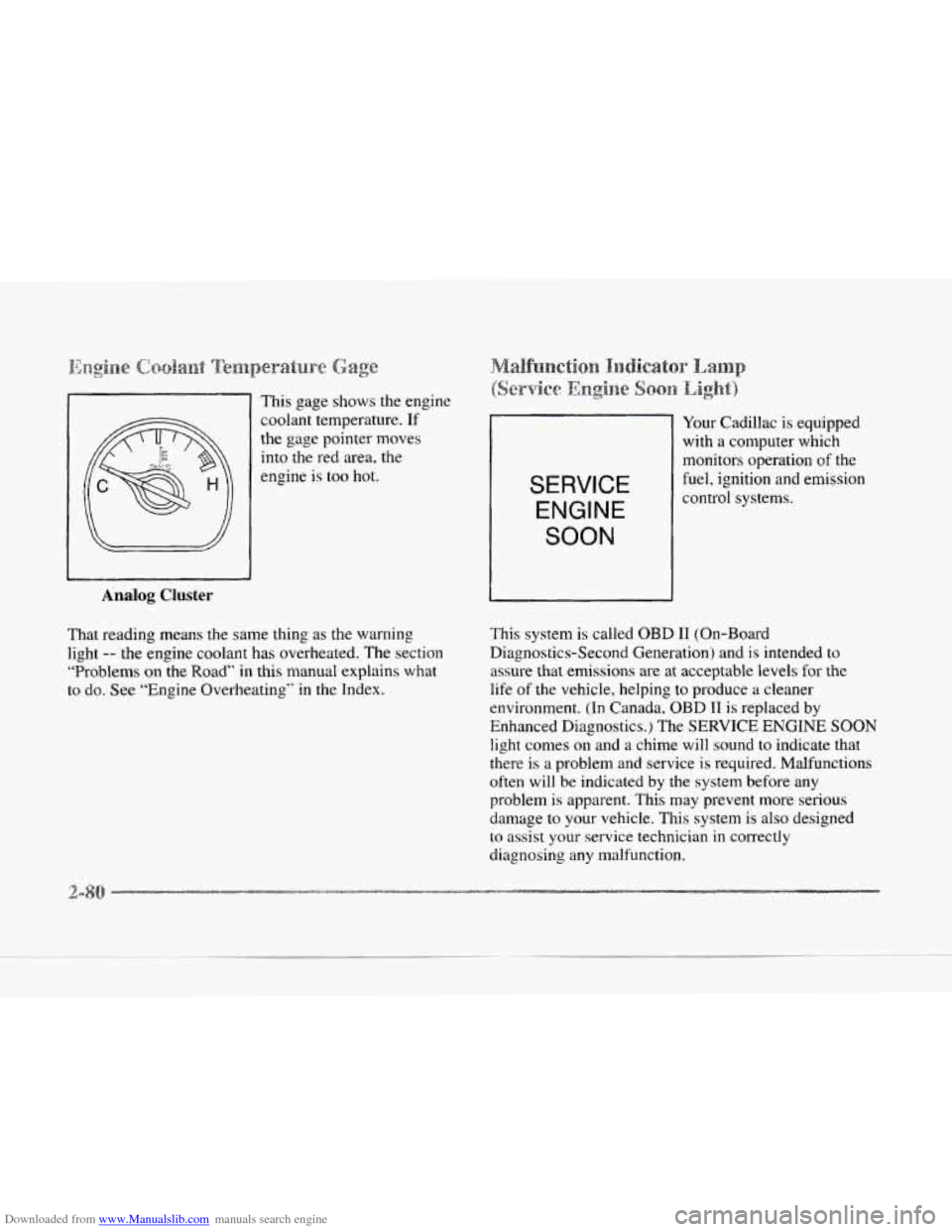
Downloaded from www.Manualslib.com manuals search engine __
Analog Cluster
This gage shows the engine
coolant temperature.
If
the gage pointer moves
into the red area, the
engine is too hot.
That reading means the same thing as the warning
light
-- the engine coolant has overheated. The section
“Problems on
the Road” in this manual explains what
to
do. See “Engine Overheating’’ in the Index.
SERVICE
ENGINE
SOON
Your Cadillac is equipped
with a computer which
monitors operation
of the
fuel, ignition and emission
control systems.
This system is called OBD I1 (On-Board
Diagnostics-Second Generation) and
is intended to
assure that emissions are at acceptable levels for the
life
of the vehicle, helping to produce a cleaner
environment. (In Canada. OBD I1 is replaced by
Enhanced Diagnostics.) The
SERVICE ENGINE SOON
light conles on and a chime will sound to indicate that
there is
a problem and service is required. Malfunctions
often will be indicated by the system before any
problem
is apparent. This may prevent more serious
damage to your vehicle. This system is also designed
to assist your service technician in correctly
diagnosing any malfunction.
c.
Page 153 of 370

Downloaded from www.Manualslib.com manuals search engine from an overheated engine. See ”Engine Overheating”
in the Index.
ENGINE MISFIRE -- EASE OFF GAS
PEDAL - 114: An engine misfire has occurred. You’ll
need to
ease off the gas pedal.
FUEL LEVEL LOW - 11: This message serves as a
waming that the fuel level in the tank is critically low.
Stop for fuel soon.
HEADLAMPS SUGGESTED - 23: If it’s dark enough
outside and the twilight sentinel control is
off, a
€EADLAMPS SUGGESTED message will display on the
DIC.
This message info~lns the driver that turning on the
exterior lamps
is recommended even though the DRL are
still illuminated (it’s become dark enough outside
to
require the headlamps andor other exterior lamps).
ICE POSSIBLE - 13: This message appears when the
outside air temperature is cold enough to create icy road
conditions.
&iONITORED SYSTEhIS OK - 1: This message only
appears in the “recall” mode by pressing the RESET
button.
It lets you know that no other messages are
stored
or cumently active.
PASS KEY NOT PROGRAMMED - 31: This
warning message displays when the PASS-Key pellet information
has not
been programmed into your vehicle.
See your Cadillac dealership for service.
PCM FAULT - 110: The circuit in the Powertrain
Control Module
(PCM) has shorted or is loose when this
message appears. Have your Cadillac serviced by your
dealership at once.
REDUCED ENGINE POWER - 41: This message
informs the driver, that due to wheel slippage, your vehicle
is reducing engine power to compensate for the loss of
traction. Accelerating too fast, causing the tires to spin, is
an example of when this message would display.
REMOVE KEY - 70: This message will appear when
the Personalized Automotive Security System
(PASS-Key
11) is unable to read the pellet on the
ignition key or an improper key pellet
has bee.n inserted.
Wait for
the DIC to display STARTING DISABLED
DUE TO THEFT SYSTEM REMOVE IGNITION
KEY. The instrument panel cluster will then run a timer
and change the messages to WAIT
3 MINUTES, WAIT
2 MINUTES, WAIT 1 MINUTE and then START CAR.
When the REMOVE
KEY message is displayed, remove
the ignition key. Check the ignition key
for damage. If it
is damaged, it may need to be replaced. If you see no
damage, clean the pellet contacts with a soft cloth or
napkin before inserting the key back into the ignition.
Have your vehicle serviced if
the message still appears.
c
Page 155 of 370
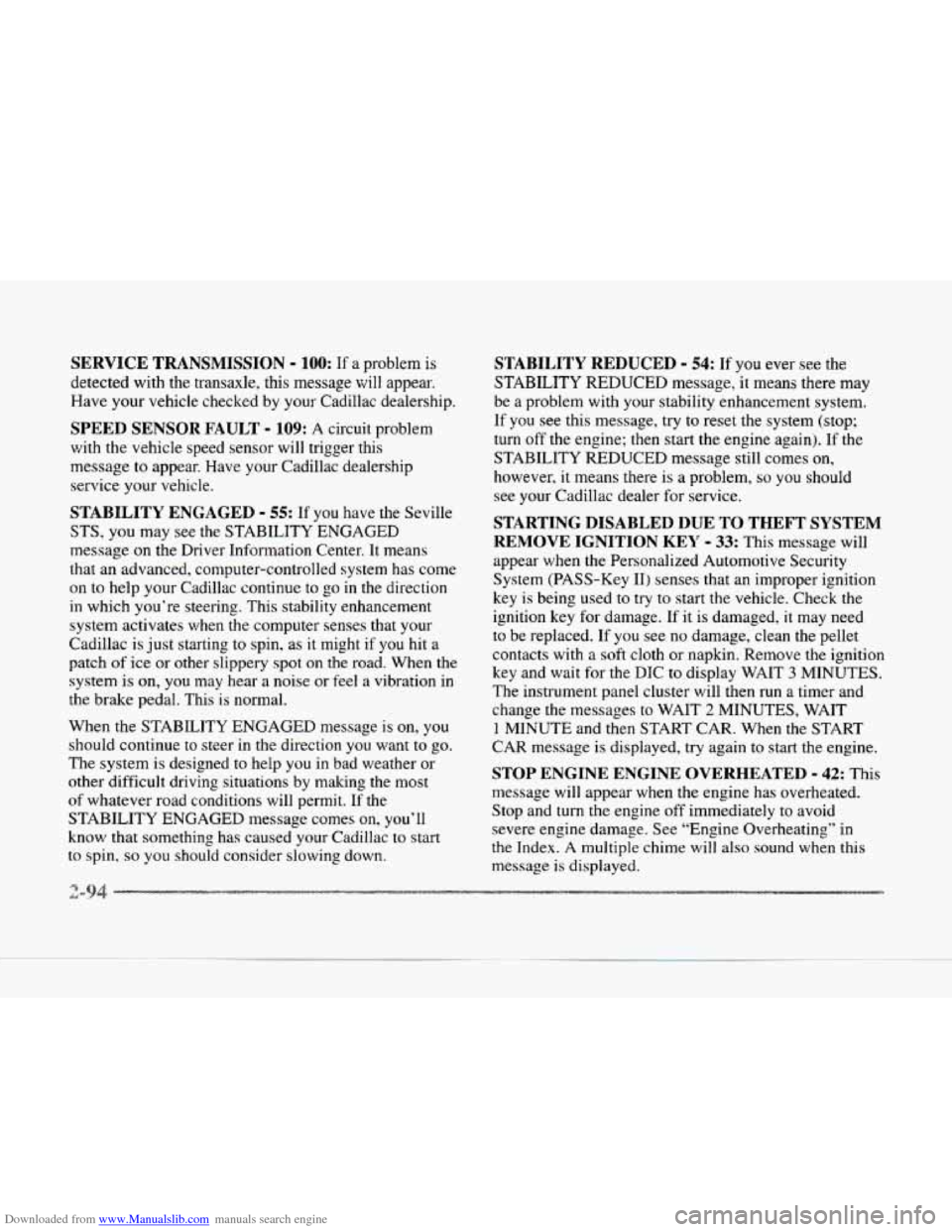
Downloaded from www.Manualslib.com manuals search engine SERVICE TRANSMISSION - 100: If a problem is
detected with the transaxle, this message will appear.
Have your vehicle checked by your Cadillac dealership.
SPEED SENSOR FAULT - 109: A circuit problem
with the vehicle speed sensor will trigger this
message
to appear. Have your Cadillac dealership
service your vehicle.
STABILITY ENGAGED - 55: If you have the Seville
STS, you may see the STABILITY ENGAGED
rnessage on the Driver Information Center. It means
that an advanced, computer-controlled system has come
on to help your Cadillac continue to go in the direction
in which you’re steering. This stability enhancement
system activates when
the computer senses that your
Cadillac is just starting
to spin, as it might if you hit a
patch of ice or other slippery
spot on the road. When the
system is
on, you may hear a noise or feel a vibration in
the brake pedal. This is normal.
When the STABILITY ENGAGED message is on,
you
should continue to steer in the direction you want to go.
The system is designed to help you in bad weather or
other difficult driving situations by making the most
of whatever road conditions will permit. If the
STABILITY ENGAGED message comes on, you’ll
know that something has caused your Cadillac
to start
to spin, so you should consider slowing down.
STABILITY REDUCED - 54: If you ever see the
STABILITY REDUCED message, it means there may
be a problem with your stability enhancement system.
If you see this message, try to reset the system (stop;
turn off the engine; then start the engine again). If the
STABILITY REDUCED message still comes
on,
however, it means there is a problem, so you should
see your Cadillac dealer for service.
STARTING DISABLED DUE TO THEFT SYSTEM
REMOVE IGNITION KEY - 33: This message will
appear when the Personalized Automotive Security
System (PASS-Key 11) senses that an improper ignition
key
is being used to try to start the vehicle. Check the
ignition key for damage. If it is damaged,
it may need
to be replaced. If
you see no damage, clean the pellet
contacts with a soft cloth or napkin. Remove the ignition
key and wait for the
DTC to display WAIT 3 MINUTES.
The instrument panel cluster will then run a timer and
change the messages to WAIT
2 MINUTES, WAIT
1 MINUTE and then START CAR. When the START
CAR message is displayed, try again to start the engine.
STOP ENGINE ENGINE OVERHEATED - 42: This
message will appear when the engine has overheated.
Stop and
turn the engine off immediately to avoid
severe engine damage. See “Engine Overheating” in
the Index. A multiple chime will also sound when this
message
is displayed.
. -.
w-